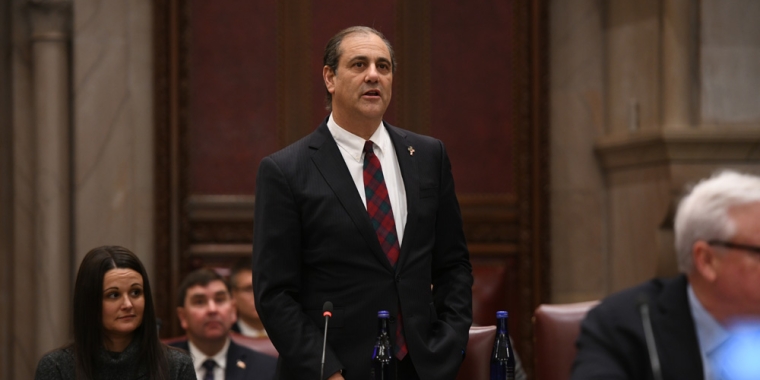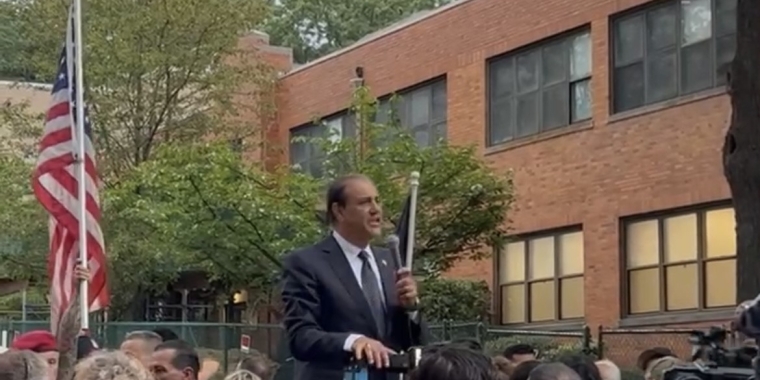
Senator Lanza Highlights Investment of $427 Million to Aid Superstorm Sandy Recovery on Staten Island
Andrew J Lanza
October 29, 2014
Governor Andrew M. Cuomo today traveled to Staten Island on the two-year anniversary of Superstorm Sandy to highlight the State's resiliency efforts, including an investment of $427 million in resiliency projects in the borough. The Governor visited the Oakwood Beach neighborhood, a low-lying area that sustained substantial damage from sea surge during the storm and has since been eligible for the State's Buyout & Acquisition Initiative to return it to a natural environment. To date, the State has extended 394 offers through the Initiative, totaling $141 million to Staten Island residents
"Staten Island suffered devastating losses two years ago due to Sandy, destroying homes, businesses and livelihoods," said Governor Cuomo. "The occurrence of 100-year storms has become the new normal, and it is imperative that we learn from the devastation caused by such disastrous weather events. The investment of $427 million has already started to help those who were affected by Sandy's destruction and will continue to help us rebuild communities so they are smarter, safer and more resilient than before."
The Governor additionally released a report today detailing the progress made by New York State in building back better in the aftermath of Superstorm Sandy. The report highlights advancements made in the areas of housing, small businesses, and infrastructure and community reconstruction through the NY Rising program, as well as a wide variety of steps taken by numerous State agencies. The report can be viewed here.
Jamie Rubin, Executive Director of the Governor's Office of Storm Recovery, said, "Our focus on Staten Island demonstrates how the State has driven recovery on a micro and macro level. Through our portfolio of NY Rising programs, the Governor's Office of Storm Recovery continues to assist individual homeowners, and entire communities, pave the way for a more resilient future."
Buyouts & Acquisitions
While visiting in Oakwood Beach, the Governor provided an overview of the State's Buyout & Acquisition Initiative and watched the demolition of a house on Fox Beach Lane. The initiative, which is part of the larger NY Rising Housing Recovery Program, addresses the needs of homeowners who experienced the substantial damage or destruction of their properties during Sandy, as well as during Hurricane Irene or Tropical Storm Lee.
In addition to Oakwood Beach, the Buyout & Acquisition Initiative is also available in the Staten Island neighborhoods of Graham Beach and Ocean Breeze. The State has received 496 applications to the program and has extended 394 offers totaling $141 million to Staten Island residents. To date, the State has facilitated 276 closings totaling $112.3 million and anticipates the total project will amount to $200 million. The State is also spending $80 million for the City's Acquisition Program.
So far, the State has demolished 47 homes on Staten Island as part of the endeavor, demonstrating progress in the recovery efforts and taking an important step toward converting land into natural coastal buffers. In addition, the State is managing $19.6 million from the U.S. Department of Agriculture to oversee another buyout of 49 properties.
Rebuild By Design
Staten Island's Living Breakwaters project, which is the borough's winning Rebuild by Design proposal located at Sprague and Surf Avenues, is another resiliency project underway on Staten Island. Initiated by the Presidential Hurricane Sandy Rebuilding Task Force in the summer of 2013, the Rebuild by Design Contest encouraged interdisciplinary firms, representing the best in planning, design and engineering, to create blueprints for recovery and resiliency efforts.
In June 2014, the U.S. Department of Housing & Urban Development announced the allocation of approximately $920 million to the winning projects, which included four from New York and two from New Jersey. With an estimated cost of $60 million, the Living Breakwaters project was designed by SCAPE/Landscape Architecture and aims to introduce breakwaters and interior tidal flats that can dissipate wave energy and slow water along the Tottenville coast.
The same undertaking will promote the restoration of sustainable oyster beds, thereby paying homage to the town's rich maritime history and creating a natural coastal buffer to protect against future storms. The SCAPE/Landscape Team was also named the recipient of the Buckminster Fuller Institute for the project. A $6.75 million dunes project developed by the NY Rising Community Reconstruction Committee complements the endeavor.
Community Reconstruction
On a community-wide scale, New York State supports and aids Staten Island through the NY Rising Community Reconstruction and Program. Through this grassroots initiative, the borough is eligible to receive $28 million to implement 21 projects proposed by its local Committee. Across the State, this innovative program is empowers storm-impacted communities and help them devise locally-oriented strategies for recovery and resiliency. The projects are:
- · Interim East Shore Coastal Protection Measures (two phases) - $2,650,000
· Tottenville and Great Kills Dunes and Coastline Dune Plantings (three phases) - $6,750,000
· Integrated South Shore Protection Plan - $400,000
· East Shore Waterfront Vision Plan - $250,000
· South Shore Resilient Dock Feasibility Study - $350,000
· 'Go to High Ground' – Study for Wayfinding Signage and Staging area for automobile evacuation - $250,000
· Staten Island 'Community Emergency Resource Center's Location and Feasibility Study - $250,000
· Provide support for the Staten Island COAD - $280,000
· Port Richmond CERT Reconnaissance, Radio Augmentation and Training - $65,000
· Home Elevation Pilot Program - $4,000,000
· Implement 'Race for Space' Grant Program to Fill Vacant Storefronts - $400,000
· Form East Shore Local Development Corporation - $600,000
· "Staten Island Resiliency Network" microgrid study - $320,000
· East Shore Microgrid Network Pilot Project - $6,000,000
· South Shore Microgrid Network Pilot Project - $4,000,000
· New Creek Bluebelt Implementation - $5,500,000
· Hylan Boulevard Streetscape Improvements: "Gateway to the Bluebelt" - $1,770,000
· St. George/Tompkinsville Promenade Master Plan - $200,000
Staten Island Railway
The Metropolitan Transportation Authority has more than $143 million in recovery projects underway for the Staten Island Railway, which suffered tremendous damage to its infrastructure when Sandy pushed seawater into low-lying areas of the railway. This work, funded by the Federal Transit Administration, includes repairs to the shop and yard complex at Clifton, as well as to the tower and interlocking at the St. George Terminal. The Metropolitan Transportation Authority has also repaired $1.2 million in damage to the Verrazano-Narrows Bridge using funding from the Federal Emergency Management Agency.
Other Funding
The State has also provided funding from a number of other federal sources, outside of Housing and Urban Development's Community Development Block Grant-Disaster Recovery Program. Making key investments into the island's critical infrastructure, the State has dedicated $12 million in Hazard Mitigation Grant Program funding to institute resiliency measures at Staten Island University Hospital – home of the largest emergency room on Staten Island and a major source of the borough's in-patient beds.
The State has also contributed $10 million in Hazard Mitigation Grant Program funding to repair and strengthen infrastructure at Richmond University Medical Center. Moreover, striving to help the borough's various non-profit organizations and community groups, the State has provided $17.2 million in Social Services Block Grant funding. And, working to safeguard parks and historic sites, the State has provided $350 million from the National Park Service to improve an protect Conference House Park; $83,000 for Voorlezer's House in Historic Richmond Town; and $52,360 to Staten Island Cemetery in Richmond County.
About the Governor's Office of Storm Recovery
The Governor's Office of Storm Recovery was established in June 2013 to coordinates statewide recovery efforts for Superstorm Sandy, Hurricane Irene, and Tropical Storm Lee. Though its NY Rising Housing Recovery, Small Business, Community Reconstruction and Infrastructure programs, the Governor's Office of Storm Recovery invests more than $4 billion, made available through the U.S. Department of Housing & Urban Development, to better prepare New York for future extreme weather events.



